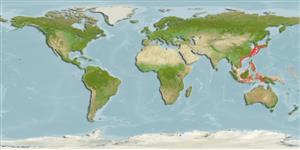Elasmobranquios (tiburones y rayas) (sharks and rays) >
Carcharhiniformes (Ground sharks) >
Proscylliidae (Finback catsharks)
Etymology: Proscyllium: pro (L.), in front of, probably referring to far forward placement of dorsal fin compared with Scyllium (=Scyliorhinus, Scyliorhinidae). (See ETYFish); habereri: In honor of German physician, anthropologist and natural history collector Karl Albert Haberer (1864-1941), who collected holotype. (See ETYFish).
More on author: Hilgendorf.
Environment: milieu / climate zone / depth range / distribution range
Ecología
marino demersal; rango de profundidad 50 - 100 m (Ref. 244). Tropical; 39°N - 8°S
Western Pacific: southeastern Japan to Viet Nam and northwestern Java, Indonesia (Ref. 13566).
Tamaño / Peso / Age
Maturity: Lm ? range ? - ? cm
Max length : 57.0 cm TL macho / no sexado; (Ref. 244); 65.0 cm TL (female)
Espinas dorsales (total): 0; Radios blandos dorsales (total): 0; Espinas anales 0; Radios blandos anales: 0. Caudal fin without a rippled dorsal margin and ventral lobe but with a strong subterminal notch; vertebral axis of caudal fin little raised above body axis (Ref. 13566). Round dark brown spots and indistinct saddles (Ref. 13566).
A little-known, uncommon bottom-dwelling shark found on the shelves of continental and insular waters (Ref. 244). Dwell on the sublittoral zone, 50-320 m (Ref. 11230). Food habits little known; probably feeding on bony fishes, crustaceans and cephalopods (Ref. 244). Oviparous (Ref. 50449), with 1 to 2 pups in a litter (Ref. 244).
Life cycle and mating behavior
Madurez | Reproducción | Puesta | Huevos | Fecundidad | Larva
Oviparous, with a single egg deposited per uterus (Ref. 244). Embryos feed solely on yolk (Ref. 50449).
Compagno, L.J.V., 1984. FAO Species Catalogue. Vol. 4. Sharks of the world. An annotated and illustrated catalogue of shark species known to date. Part 2 - Carcharhiniformes. FAO Fish. Synop. 125(4/2):251-655. Rome: FAO. (Ref. 244)
IUCN Red List Status (Ref. 130435)
Human uses
Pesquerías: pesquerías de subsistencia
Más información
Age/SizeCrecimientoLength-weightLength-lengthLength-frequenciesMorfometríaMorfologíaLarvaDinámica larvariaReclutamientoAbundanciaBRUVS
ReferenciasAcuiculturaPerfil de acuiculturaRazasGenéticaElectrophoresesheritabilidadEnfermedadesProcesamientoNutrientsMass conversion
ColaboradoresImágenesStamps, Coins Misc.SonidosCiguateraVelocidadTipo de nataciónSuperficie branquialOtolitosCerebrosVisión
Herramientas
Special reports
Download XML
Fuentes de Internet
Estimates based on models
Preferred temperature (Ref.
123201): 17.4 - 28, mean 25.1 °C (based on 134 cells).
Phylogenetic diversity index (Ref.
82804): PD
50 = 0.6328 [Uniqueness, from 0.5 = low to 2.0 = high].
Bayesian length-weight: a=0.00389 (0.00180 - 0.00842), b=3.12 (2.94 - 3.30), in cm total length, based on all LWR estimates for this body shape (Ref.
93245).
Nivel trófico (Ref.
69278): 4.1 ±0.57 se; based on food items.
Resiliencia (Ref.
120179): Muy bajo, población duplicada en un tiempo mínimo superior a 14 años (Fec = 1-2).
Fishing Vulnerability (Ref.
59153): Moderate to high vulnerability (46 of 100).
